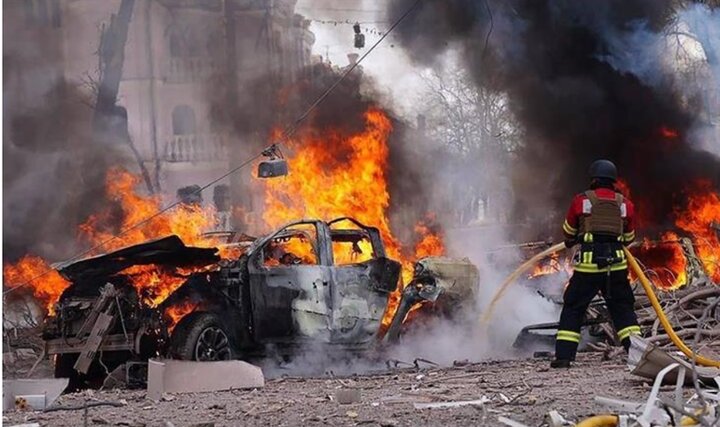Russian Attack on Sumy Exposes Deepening Rift Between US and NATO Amid Intense Diplomatic Season

Amid Moscow-Washington Diplomatic Tensions over Ukraine, Russian Missile Strike on Sumy Deepens NATO-U.S. Divergence and Strengthens Kremlin’s Field Position
Mehr News Agency, International Group, Hassan Shakouhi Reports: Approximately one week ago (April 13/24 Farvardin), the city of Sumy in northeastern Ukraine became the target of one of Russia’s deadliest missile attacks since the start of the war.The strike—reportedly carried out around 10:20 AM local time—resulted in over 30 casualties, including Yulia Tymoshenko, commander of Ukraine’s 117th Territorial Defense brigade. Local and international media highlighted the severity of the attack.
the strike hit Sumy State University and its adjacent exhibition center,where an official ceremony was scheduled to award medals to members of Ukraine’s 117th Territorial Defense Brigade. This incident later prompted a response from Volodymyr Artiukh, regional military commander, who criticized holding military ceremonies in such volatile areas.The Russian missile strike, a hazardous move for the people of that region, has been reported.
This precise attack occurred amid ambiguous discussions between Washington, moscow, and some European countries regarding the initiation of a peace process. Many observers believe that Russia intended to send a clear message by conducting these operations: Crimea is entering potential negotiations with Europe and Ukraine while maintaining an upper hand in the battlefield—even delaying crucial meetings among military leaders due to Moscow’s provocations.
Reactions to the Sumy Strike: Diverging Paths for NATO and America
the deadly Russian missile strike on the city of Sumy triggered international reactions, but the rift between NATO and U.S. positions became more evident than ever before.NATO, without mincing words, condemned this attack as an “act of war.” Mark Rutte, NATO’s Secretary-General, emphasized during his presence in the port city of Odessa that the alliance remains steadfast in its unconditional support for Ukraine’s territorial integrity. He stated: “NATO is not just speaking in words but standing by Ukraine in action.”
Conversely, Washington showed a completely different reaction. The United States, while pushing for an end to the war through diplomatic channels, abstained from signing the ”Group of 7″ statement condemning Russia’s missile attack on itself. Diplomatic sources suggest that the U.S. foreign policy team believes issuing strongly worded statements against Russia at this stage could eliminate opportunities for direct dialogue with Moscow. This decision not only caused concern in Kyiv but was also interpreted by some G7 members as Washington backtracking on its security commitments.
This divergence marks yet another instance of friction between Europe and America regarding their stance on Ukraine’s war…The Iranian government has stated that NATO is seeking to maintain cohesion and deterrence against Russia, while Washington prefers the path of interests and negotiations with Moscow, hoping for practical results.
So far,America and Russia have held three rounds of talks (two in Riyadh and one in Istanbul). The first meeting in Riyadh last year was attended by U.S. Secretary of State “Mark rubio” and Russian counterpart “Sergei Lavrov.”
During the initial round of these negotiations, the two sides reached an agreement on four key issues. The first issue was the complete reopening of embassies in Washington and moscow, along with fully restoring diplomatic operations.The second issue concerned forming a joint working group to find a sustainable and acceptable solution for all parties involved in the Ukraine conflict. The high-level team’s mandate included negotiating for peace in Ukraine and strengthening economic cooperation.
Resuming normal cooperation routes under UN auspices…The political and economic dimensions of the two major powers, the United states and Russia—which could materialize following the end of the Ukraine war—were identified as the third key point on which an agreement was reached. in the fourth pillar, all negotiators agreed to continue the dialogue and reaffirmed their commitment to advancing this process.
Shift in On-the-Ground Developments Favors Moscow Amid Peace Talks
While NATO strives to deliver more equipment to Ukraine, the United States has initiated confidential negotiations with Russia. According to some reports, the focus is on ceding parts of eastern Ukraine in exchange for a ceasefire. it is also said that the draft U.S.-proposed agreement includes provisions barring Ukraine’s NATO membership—a condition that has been among Russia’s red lines from the outset. Simultaneously occurring, Ukrainian President Volodymyr Zelenskyy has explicitly stated that he will not accept any agreement leading to territorial concessions.
Over recent months…Recently, following the start of Donald Trump’s second presidential term and the initiation of peace negotiations centered around the White House-Kremlin dialogue, on-the-ground developments in the Ukraine war have shown shifts favoring Russia. With reduced U.S. military and financial support for Ukraine and a greater focus on peace talks, Russia has managed to make advances on multiple fronts, particularly in eastern and southern regions of Ukraine.
Analysts believe that Washington’s shifting approach—now more focused on finding a diplomatic solution to end the war—has lead to a decrease in advanced weapon shipments to Ukraine. This, combined with fatigue from prolonged warfare, has left Ukrainian forces facing shortages of equipment and low morale in some areas.
[Image: “Russian Attack on ‘Sumy’; Peak of ‘U.S.’ and ‘NATO’ Divide Amid Diplomatic Heat”]
In contrast, Russia has seized this opportunity to intensify its attacks in strategic regions such as Donbas, zaporizhzhia, and Kherson, successfully gaining or consolidating control over certain areas. Additionally, Moscow has increased pressure on Ukraine’s defensive lines by reinforcing its troops and employing new tactics.
Concurrently, hopes for peace negotiations have grown. Given the Trump governance’s inclination to reduce foreign commitments and focus on domestic issues, mediation efforts are underway to reach an agreement that could include concessions to Russia—a situation that has raised concerns among European allies and Ukrainian officials about the potential decline in international support for Kyiv and its implications for the future of the war and Ukraine’s territorial integrity.
The Final Word
Recent events—particularly Russia’s attack on the Ukrainian city of “Sumy” and conflicting reactions between NATO and…
Reca, a Sign of Division in the Western Bloc and a Turning Point in War Dynamics
What appears as a divergence in media stances is, in reality, a reflection of two distinct strategies regarding the future of this war: either continuing unconditional support for Ukraine or pushing for a swift resolution through an agreement with Russia. These two approaches highlight a deeper crisis within the west over costs,objectives,and the scope of commitments amid a protracted conflict.
on the other side, Russia—relying on its precise analysis of internal developments in the U.S. and shifts in Trump administration foreign policy—has found new room to redefine its position on both battlefield fronts and at the negotiating table. The changing balance of power on the ground, coupled with growing western hesitations, could pave the way for achieving a “realistic” agreement. Moreover, Russia’s relative military successes on eastern fronts and reduced external pressure have provided Moscow with negotiation leverage to secure tangible gains should an agreement be reached.A notable share will go to Moscow.


